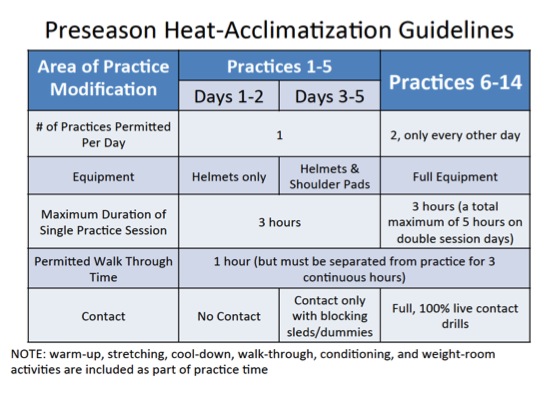Heat acclimation or acclimatization plays a large part in the body’s physical responses and overall ability to cope with heat exposure. Heat acclimation is a broad term that can be loosely defined as a complex series of changes or adaptations that occur in response to heat stress in a controlled environment over the course of 7 to 14 days. These adaptations are beneficial to exercise in the heat and allow the body to better cope with heat stress. Heat acclimatization describes the same process, but happens in a natural environment. In either case, the positive adaptations that occur include reductions in:
- Heart rate
- Internal body temperature responses
- Skin temperature responses
- Sweat electrolyte concentrations
- Rating of perceived exertion
As well as increases in:
- Sweat rate
- Sweat onset (sweating starts earlier)
- Blood flow
- Exercise performance in the heat and cooler conditions
All of these changes improve an athlete’s ability to handle heat stress during exercise.
It is also important to note that factors affecting these changes determine the extent to which adaptations occur. For example, acclimation in hot and dry environments has been shown to be different from that in hot and humid environments (a greater sweat rate increase has been seen in the latter case). Acclimation is also known to depend on volume of exercise, intensity, duration and maintenance of an elevated internal body temperature during exercise.
When preparing to acclimatize to the heat, athletes should gain a base level of fitness in a cooler environment prior to heat exposure. Fit individuals already have some of the physical advantages that are gained with acclimation—for example, an increased sweat rate. Guidelines have been introduced for the high school population for the purpose of gradual heat acclimatization during the preseason.
Heat Acclimatization Tips
There are steps you can take to help your body acclimatize to a new environment:
- Do not participate in more than one practice per day in the first five days of practice
- Do not practice more than three hours in one day for the first five days of practice
- Do not wear full gear until day six of practice
- For full-contact sports, live full-contact drills should not be used until day six of practice
- For double-practice days, they must be followed by a single-practice day or day of rest
- On double-practice days, each practice should not exceed 3 hours including stretching, warm-up, cool-down and lifting
- Do no participate in more than five hours of practice total for double-practice days from day six through fourteen
- Be properly hydrated before, during and after practice
- Gradually increase the intensity of practice over the course of a few days
- Increase the amount of sodium in your diet for the first days of practice to make up for sweat salt loss
- Avoid practicing while sick
- Have cooling methods available during practice (ice towels, ice tubs)
- Take breaks frequently to avoid your body overheating
- Get plenty of sleep the nights before practices
Make sure to monitor for signs of exertional heat stroke (EHS), heat exhaustion and heat syncope during the initial days of acclimatization. Having an athletic trainer available on-site before, during and after practice can help monitor athletes for exertional heat illnesses. When practicing or having an event in a hot and humid environment, assessment of risk can be made using a Wet Bulb Globe Temperature monitor.
Heat Acclimatization Guidelines
The body of evidence supporting heat acclimatization is large. By not mandating heat acclimatization guidelines, states are failing to protect their athletes and, in fact, are placing them at greater risk for exertional heat stroke and other heat-related illnesses. Coaches, school leadership, parents and legislators must push their states to establish guidelines or have inadequate guidelines revised. The Korey Stringer Institute staff is readily available to assist with this process and when reviewing states polices utilize the guidelines set forth by the NATA in the consensus statement:
Casa DJ, Csillan D. Preseason Heat-Acclimatization Guidelines for Secondary School Athletics. J Athl Train. 2009;44(3):332-333.
Recently, state high school athletic associations have started to acknowledge the importance of heat acclimatization, and have adopted the 2009 guidelines released by the National Athletic Trainers’ Association for secondary schools. These were modeled after the 2003 guidelines that the NCAA implemented. With the assistance of Korey Stringer Institute, many states have adopted these guidelines into their state athletic association handbooks. A timeline of adaptation of heat acclimatization guidelines can be seen below.
Regrettably, athletes are still suffering and dying from exertional heat stroke. This can be changed and many lives can be saved by speaking up and supporting mandatory state guidelines for heat acclimatization.
Heads Up Football Heat and Hydration Guidelines
References
- Armstrong L, Maresh C. The induction and decay of heat acclimatisation in trained athletes. Sports Med.1991;12(5):302–312.
- Casa D, Csillan D. Preseason heat-acclimatization guidelines for secondary school athletics. J Athl Train. 2009;44(3):332–333.
- Pandolf K. Effects of physical training and cardiorespiratory physical fitness on exercise-heat tolerance: recent observations. Med Sci Sports Exerc. 1979;11:60–65.
- Pandolf K. Time course of heat acclimation and its decay. Int J Sports Med. 1998;19:S157–S160.
- Pawelczyk J. Neural control of skin and muscle blood flow during exercise and thermal stress. In: Gisolfi CV, Lamb DR, Nadel ER, eds. Exercise, Heat and Thermoregulation. Traverse City, MI: Cooper Publishing Group; 2001.
- Poh PYS, Armstrong LE, Casa DJ, et al. Orthostatic hypotension after 10 days of exercise-heat acclimation and 28 hours of sleep loss. Aviat Space Environ Med. 2012;83:403–11.
- Casa DJ, DeMartini JK, Bergeron MF, Csillan D, Eichner RE et al. National Athletic Trainers’ Association Position Statement: Exertional Heat Illnesses. J Athl Train. 2015; 50(9):986-1000.
Page Last Modified on August 11th, 2019
